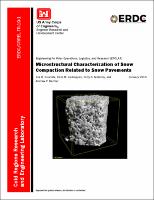Please use this identifier to cite or link to this item:
https://hdl.handle.net/11681/31442Full metadata record
| DC Field | Value | Language |
|---|---|---|
| dc.contributor.author | Courville, Zoe R. | - |
| dc.contributor.author | Lieblappen, Ross M. | - |
| dc.contributor.author | Melendy, Terry D. | - |
| dc.contributor.author | Bernier, Andrew P. | - |
| dc.date.accessioned | 2019-01-22T20:56:39Z | - |
| dc.date.available | 2019-01-22T20:56:39Z | - |
| dc.date.issued | 2019-01 | - |
| dc.identifier.govdoc | ERDC/CRREL TR-19-1 | - |
| dc.identifier.uri | http://hdl.handle.net/11681/31442 | - |
| dc.identifier.uri | http://dx.doi.org/10.21079/11681/31442 | - |
| dc.description | Technical Report | - |
| dc.description.abstract | A first-of-its-kind snow runway for wheeled aircraft operation at McMurdo Station, Antarctica, demonstrated that robust structures can be made of snow that push the limit of what is known about snow strength and how to parameterize it. We conducted a series of laboratory tests to determine the links between snow density and snow compressive strength for very high-density snow structures. We constructed snow samples of varying densities to mimic the snow structures of the constructed runway and measured the resulting snow microstructural and mechanical properties. The goal of this work is to ultimately increase our understanding of the role of density, as an easy-to-measure parameter, in determining snow strength as it relates to snow construction applications (e.g., snow runways, tunnels, and foundations) and how to best quantify the relationships between microstructure, density, and strength of very dense snow structures. Our values for the mechanical properties compared relatively well with the compilation of past historical results. Based on our results, to a first order approximation, snow microstructure data can be used to help improve snow strength predictions. Important future work would focus on improving these snow microstructure-strength relationships to include the effects of meteorological forcing. | en_US |
| dc.description.sponsorship | Engineering for Polar Operations, Logistics, and Research Program (U.S.) | en_US |
| dc.description.sponsorship | National Science Foundation (U.S.). Office of Polar Programs. | - |
| dc.description.tableofcontents | Abstract .......................................................................................................................................................... ii Figures and Tables ........................................................................................................................................ iv Preface ............................................................................................................................................................ vi Acronyms and Abbreviations .....................................................................................................................vii 1 Introduction ............................................................................................................................................ 1 1.1 Background ..................................................................................................................... 1 1.2 Objectives ........................................................................................................................ 1 1.3 Approach ......................................................................................................................... 1 1.4 Prior Work ........................................................................................................................ 2 1.4.1 Snow runway development ...................................................................................................... 2 1.4.2 Snow strength as a function of snow structure ...................................................................... 4 2 Laboratory Methods ............................................................................................................................. 5 2.1 Snow-sample preparation .............................................................................................. 5 2.2 Microstructural characterization .................................................................................... 6 2.3 Compression testing ....................................................................................................... 8 3 Results ..................................................................................................................................................12 3.1 Stress-strain curves ...................................................................................................... 13 3.2 Microstructure evolution .............................................................................................. 18 3.2.1 Porosity during compression ................................................................................................. 18 3.2.2 Surface-to-volume ratio during compression........................................................................ 19 4 Discussion ............................................................................................................................................ 23 4.1 Comparison to published results ................................................................................. 23 4.1.1 Elastic modulus ...................................................................................................................... 23 4.1.2 Compressive failure strength................................................................................................. 24 4.2 Microstructural parameterizations of snow strength .................................................. 26 4.2.1 Density vs. min-cut parameterizations of strength............................................................... 26 4.2.2 Microstructure parameterizations based on density and min-cut ...................................... 28 4.2.3 Elastic modulus, yield strength, and unconfined compressive strength ............................ 28 5 Conclusions .......................................................................................................................................... 29 References ................................................................................................................................................... 30 Report Documentation Page | - |
| dc.format.extent | 43 pages / 4.050 Mb | - |
| dc.format.medium | PDF/A | - |
| dc.language.iso | en_US | en_US |
| dc.publisher | Cold Regions Research and Engineering Laboratory (U.S.) | en_US |
| dc.publisher | Engineer Research and Development Center (U.S.) | en_US |
| dc.relation.ispartofseries | Technical Report (Engineer Research and Development Center (U.S.)) ; no. ERDC/CRREL TR-19-1 | - |
| dc.rights | Approved for Public Release; Distribution is Unlimited | - |
| dc.source | This Digital Resource was created in Microsoft Word and Adobe Acrobat | - |
| dc.subject | EPOLAR | en_US |
| dc.subject | McMurdo Station (Antarctica) | en_US |
| dc.subject | NSF | en_US |
| dc.subject | Snow | en_US |
| dc.subject | Snow--Microstructure | en_US |
| dc.subject | Snow compressive strength | en_US |
| dc.subject | Snow mechanics | en_US |
| dc.subject | Snow pavement | en_US |
| dc.subject | Snow runways | en_US |
| dc.subject | Snow yield strength | en_US |
| dc.subject | Young's modulus | en_US |
| dc.title | Microstructural characterization of snow compaction related to snow pavements | en_US |
| dc.type | Report | en_US |
| Appears in Collections: | Technical Report | |
Files in This Item:
| File | Description | Size | Format | |
|---|---|---|---|---|
| ERDC-CRREL TR-19-1.pdf | 4.15 MB | Adobe PDF |  View/Open |